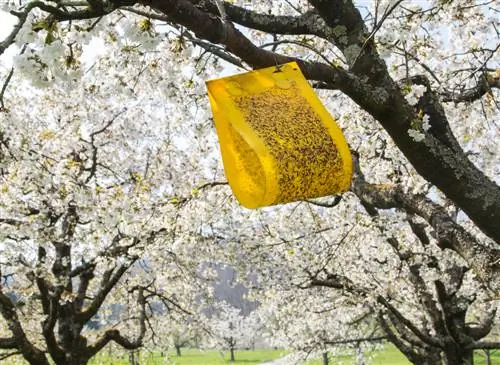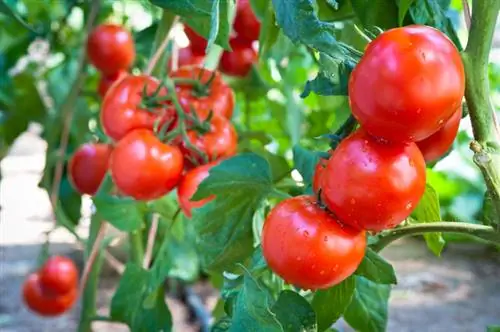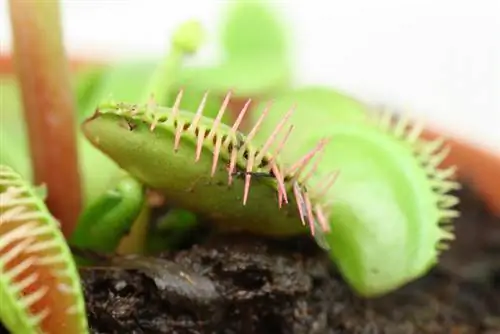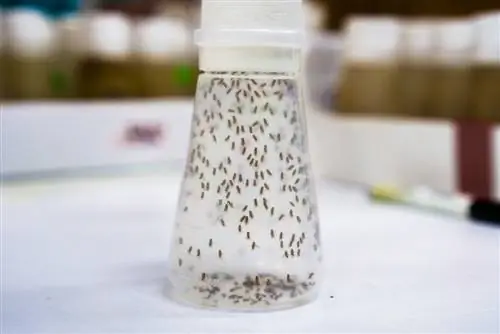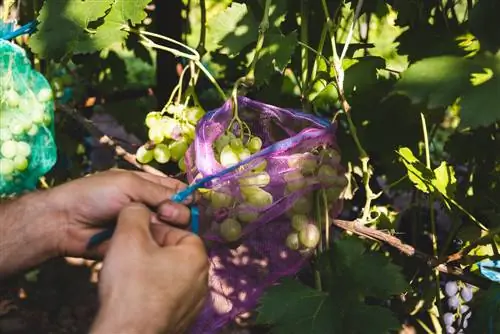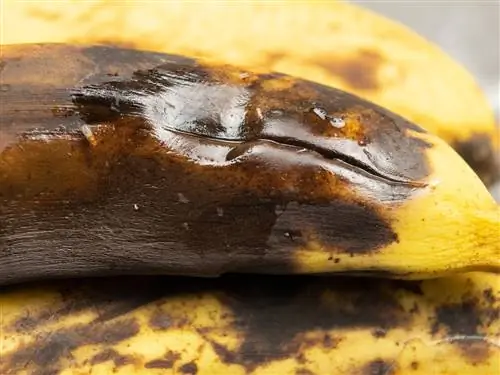- Author admin [email protected].
- Public 2023-12-26 14:17.
- Last modified 2025-06-01 06:02.
When nasty worms swarm in cherries, the cherry fruit fly causes mischief in the orchard. Read this guide on how to recognize the pest and combat it using natural means. Field-tested instructions explain which control methods against Rhagoletis cerasi work for juicy cherries without nasty maggots.
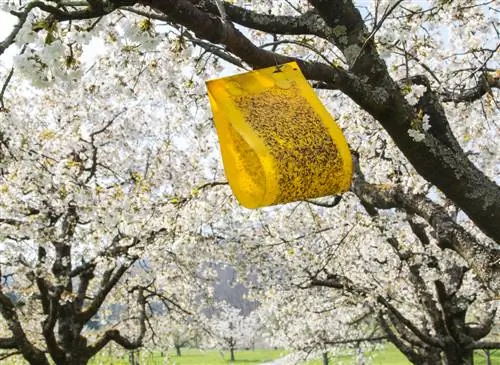
How to get rid of cherry fruit flies naturally?
To combat cherry fruit flies, cover the ground around the tree with fleece, use protective nets and yellow boards and use natural sprays such as nematodes or wormwood tea, as well as beneficial insects such as parasitic wasps and chickens.
- The cherry fruit fly is 3-5 mm small, black, has a yellow tag on its back and has transparent wings with black-blue horizontal stripes.
- Fighting cherry fruit flies is possible with protective nets, yellow boards, ground fleece and the beneficial insects parasitic wasps and chickens.
- Natural sprays are nematodes in water and wormwood tea.
What are cherry fruit flies?
The mastermind behind spoiled cherries full of maggots is the cherry fruit fly (Rhagoletis cerasi) from the drill fly family (Tephritidae). The fly is a dangerous pest on cherry trees because females use the fruit as a breeding station for their brood. This appearance makes a cherry fruit fly unmistakable:
- Twill length: 3 to 5 mm
- Body coloring: black with yellow dots on head and torso
- Wings: transparent with black-blue cross bands
- Eyes: bright green compound eyes
- Special feature: yellow tag on the back
The larva of a cherry fruit fly is 4 to 6 mm long with a creamy white, worm-like body.
This is how maggots get into cherries
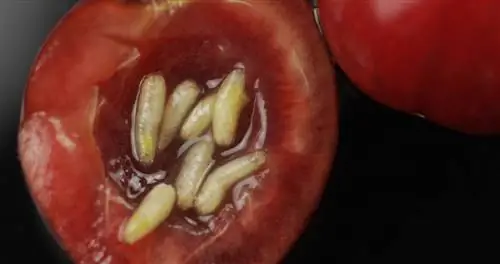
Maggots in cherries are extremely unpleasant
The flight season begins in mid-May. Until then, cherry fruit flies have overwintered in the soil at a depth of about 5 centimeters. The insects fly purposefully to a cherry tree and initially dedicate themselves to 14 days of ripening. Freshly strengthened, the fruit flies turn to family planning. Mated females wait patiently for the color of ripening cherries to change from green to yellow, setting the following vicious circle in motion:
- Laying the eggs: with a single stab into a cherry just below the fruit peel
- Hatching of a larva: within a week (5 to 8 days)
- First action: Larva pierces the cherry to the core
- Maggot eating: 30 day long eating orgy in the pulp
- Damaging image: rotten fruits that fall off half ripe
Fed up maggots fall down with the spoiled cherries or abseil down. In no time at all, each adult larva buries itself in the ground, where it pupates and hibernates. The serious damage to the cultivation of sweet and sour cherries is due to an explosive proliferation. A single female cherry fruit fly lays 50 to 80 eggs during the flight season between May and July, so just a few specimens are enough to destroy the entire harvest on a cherry tree.
Fighting cherry fruit fly - biological control at a glance
The close relationship between flight time and yellowing of the fruit makes the cherry fruit fly vulnerable. Because chemical agents are frowned upon in home gardens, the focus is on biological control. The following table gives a compact overview of how you can effectively prevent female fruit flies from laying fatal eggs using natural methods:
| Mechanical means | Natural sprays | Beneficial insects |
|---|---|---|
| Protective net | Nematodes | Parasitic wasps |
| Yellow boards | Wormwood tea | Chickens |
| Fleece cover floor |
In the following video from the Schreiber tree and vine nursery, effective control measures against cherry fruit flies are explained in a practical manner:

Mechanical control - instructions for hobby gardeners
Informed hobby gardeners know: Prevent cherry fruit flies from laying eggs and your cherries will remain free of maggot infestation. Mechanical control methods are the best option in the home garden. The right time is just as important as correct application. The following instructions explain step by step how to keep pests away from your valuable cherry tree so that you can enjoy juicy fruit without nasty worms:
Fight cherry fruit fly with net
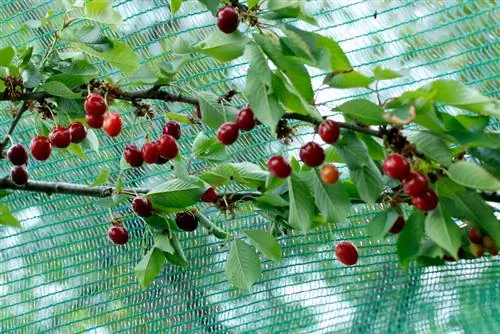
The mesh size of protective nets against fruit flies should not be more than 1.3 mm
If a cultural protection net surrounds the cherry tree, cherry fruit flies have no access. Females are denied the opportunity to lay their eggs on the ripening fruits. Ready-made protective nets (€13.00 on Amazon) from specialist retailers have a zipper. This saves you annoying climbs on the ladder when you put the net on or take it off.
Nets with a mesh size of 0.8 to 1.3 mm offer perfect protection. A protective net is used after the flowering period so that bees, bumblebees and butterflies can fulfill their role as pollinators. The cherry tree should be equipped with a culture protection net at the latest before the green fruits change color to yellow. Leave the hood on the cherry tree until shortly before harvest.
Excursus
Eating cherry fruit fly maggots - harmful to he alth?
100 percent protection against cherry fruit flies has yet to be invented. Every now and then, clever cherry fruit flies sneak through and leave wormy fruit behind. Concerned hobby gardeners are rightly asking themselves: What to do with infected cherries? Can you eat cherry fruit fly maggots or is it dangerous to your he alth? Competent nutritionists give the all-clear. Intentional or unintentional consumption of maggots is not harmful to he alth. In fact, many people around the world consider insect larvae to be food and an important source of protein.
Use yellow boards correctly
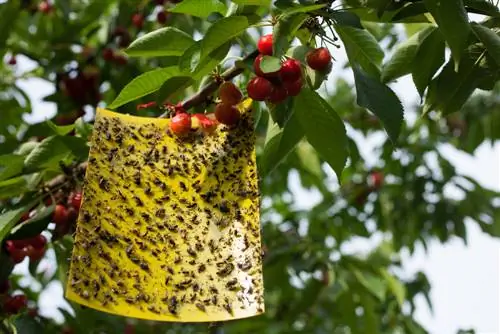
Cherry fruit fly infestations can be significantly reduced using yellow plates
For female cherry fruit flies, the color change from green to yellow is the signal to lay eggs on sweet and sour cherries. Yellow panels use this phenomenon to catch the fruit fly ladies. These are yellow sticky traps with a special attractant without chemical additives. In commercial fruit cultivation, yellow plates are primarily used to determine the level of infestation. On a single cherry tree in your home garden, you can use yellow panels to reduce the infestation by up to 50 percent if you proceed as follows:
- Hang up yellow plaques in the cherry tree in early/mid May
- Distribute at least 8 to 10 sticky traps evenly in the treetop
- Important: Until the end of the flight season (end of July), replace the yellow plates regularly according to the manufacturer's instructions
You can increase the attraction of yellow board attractants with a simple trick. To do this, fill a little organic liquid fertilizer into a small PET bottle. Hang the bottle without the cap directly under a yellow glue trap. The intense smell of the contents significantly optimizes the attractiveness of the special glue.
Floor fleece repels cherry fruit flies
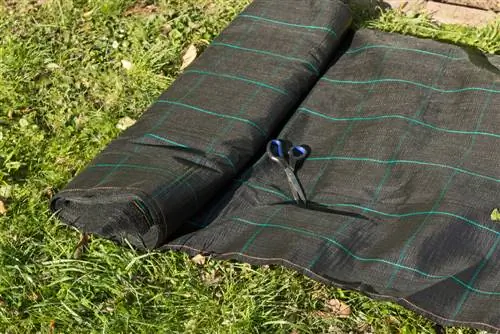
Weed fleece must be laid out over a large area in order to effectively protect against awakening cherry fruit flies
You can catch cherry fruit flies with a ground fleece on the root disk when the insects leave their winter quarters below the surface of the earth. A weather-resistant garden fleece that also suppresses annoying weeds is well suited. Alternatively, cover the tree disc with a close-meshed cultural protection net or a mulching film. Please fix the fleece edges completely with earth or gravel to prevent loopholes.
If there were maggots on cherries in the previous year, please cover all tree slices within a radius of 200 meters with fleece, net or foil. It is to be feared that cunning cherry fruit flies will hide in the ground at this distance. The covers are only removed after the harvest.
Good to know: A ground cover is the best solution if the treetop is too large for a crop protection net. If you don't want to miss out on the effectiveness of a protective net against cherry fruit flies, give your cherry tree regular, expert pruning care.
Natural sprays against cherry fruit flies
Two natural sprays provide effective assistance in the biological control of cherry fruit flies. One remedy contains beneficial insects that destroy full-fledged larvae when they leave the cherry tree. The second remedy is a plant tea that is supposed to prevent female fruit flies from laying eggs. The following instructions explain how to do it correctly:
Nematodes versus cherry fruit fly
Stir nematodes of the type Steinernema feltiae into lukewarm water. Pour the liquid into a watering can with a watering bar. At the beginning of June, water the root slice of the cherry tree on a mild, dry morning. The nematodes parasitize the larvae and prevent you from having to complain about maggot-infested cherries again next year. Nematodes are not sufficient as the sole biological control agent. After all, success rates of up to 50 percent have been recorded.
Tip
For nature-oriented hobby gardeners, resorting to pesticides to chemically combat the cherry fruit fly is not an option. There is too great a risk that toxic pesticides will be stored in the cherries and ingested when consumed. A look at the online database of the BVL (Federal Office for Consumer Protection and Food Safety) reveals that no pesticides are currently approved for home gardens anyway.
Wormwood tea for maggot-free cherries

Wormwood is a proven natural remedy against cherry fruit flies
Prepare a tea with 150 grams of wormwood leaves and 5 liters of water. Ideally, let the brew steep for 24 hours and strain out the overcooked leaves. Then fill the wormwood tea into a pressure sprayer and spray the cherry tree crown. When you spray is crucial for the success of the control. In the fourth week after the cherry blossoms, spray the green fruits for the first time. Continue the treatment until the delicate phase of yellow-skinned cherries is over.
Beneficial insects - organic trump card against cherry fruit flies
In the natural garden, beneficial insects make short work of cherry fruit flies. Where birds, ground beetles, spiders and parasitic wasps feel safe, the pests have little chance of leaving their winter quarters in the ground alive. Mixed hedges with native wild fruit bushes, green dry stone walls, piles of leaves and dead wood invite many beneficial insects to linger. As reinforcement, home gardeners hire hard-working chickens and busy ducks who enthusiastically hunt cherry fruit flies and other pests in the garden.
Frequently asked questions
What to do if the cherry tree is too big for a cultural protection net?
On mature, rarely or never pruned cherry trees, the crowns are often too large for a cultural protection net. In this case, we recommend covering the ground with garden fleece, protective net or foil. The complete covering of a root disc prevents overwintered cherry fruit flies from flying into the treetop after hatching in the ground.
Do biological sprays help against cherry fruit flies during the flowering period?
No. It is a common misconception among hobby gardeners that sprays combat cherry fruit flies during the flowering period. Recommended plant protection products for the cherry tree during the flowering period combat the cherry blossom moth. However, this pest does not lay eggs on the fruit and is therefore not responsible for maggot-infested cherries.
What can you do to prevent maggots in sweet and sour cherries?
In the organic garden you can take various precautions in advance against cherry fruit flies in the cherry tree. Cover the root slice with a fleece. This measure prevents the insects from flying to a cherry tree after overwintering in the ground. An underplanting of lily of the valley and repeated watering with tansy or wormwood decoction help to defend against the pests. After harvesting, clear all fruit mummies from the tree and the ground and dispose of them in organic waste and not in the compost.
Tip
Early cherry varieties are immune to nasty maggots. When the cherry fruit fly begins its flight period, early-ripening sweet and sour cherries have long since completed the dangerous, yellow ripening stage. The cherry varieties 'Red May Cherry', 'Giorgia', 'Burlat' and 'Earlise' promise delicious fruit enjoyment without maggot infestation.'Kassins Early Heart Cherry' gives you juicy, sweet cherries in premium quality without a single unappetizing larva.

